Going green energy and building “autonomous houses”

In Greek mythology, there is an animal that lives by eating its own tail. When one tail is eaten, another tail will be born. The English name of this animal is Ouroboros, which is translated from the Greek homophone. The Greek word Ouro means eating, and Boros means tail, usually translated as tail-eating snake or tail-eating dragon. 1
If this animal really exists, its way of survival is the most environmentally friendly. For many years people have dreamed of building a house that uses no or very little external energy. One of the authors (Chen Shaoming) once called it "Autonomous House" or "Self-sufficient House" in the article "Energy Conservation Architecture" published in China's "Architect" magazine thirty years ago. House" (Self-Sufficient House). 2 At that time, many knowledgeable people had proposed some solutions similar to those now, but they did not receive widespread attention. Furthermore, these solutions were still in their imperfect initial stage.
Today's science and technology has become quite advanced, and it is urgent to solve the problem of greenhouse effect. Nowadays, it is possible to build a house that does not require external energy at all. Let’s call this kind of house that can generate its own energy “Ouroboros House” or “autonomous house”.
The rise of green energy
Psalm 23 says:"The Lord is my shepherd; I will never be in want. He makes me lie down in green pastures and leads me beside still waters..."What a beautiful ecological environment this is! But out of greed, people wantonly destroy the earth, cut down trees in large numbers, and exploit oil, causing global climate change and rising temperatures. Some environmental authorities believe that if this trend is not changed immediately, it will be irreversible in a few years.
The impacts of climate change are even more unfair to poor and small countries that are unable to cope. For example, Africa, which accounts for only 2% of the world's carbon emissions, has to endure the unknown injustice of years of drought caused by climate change. The beautiful island country of Mauritius in the Indian Ocean recently held a unique underwater cabinet meeting to draw attention to the fact that if the world heats up again, the country will sink to the bottom of the sea.
In the face of this crisis, leaders around the world and people from all walks of life should mobilize. Only if everyone holds this sense of urgency and mission can the crisis be resolved. Especially in the United States, its 300 million people only account for 4.7% of the world's total population, but in the past it consumed nearly a quarter of the world's energy and emitted nearly a quarter of carbon dioxide; China's industry has developed rapidly in recent years. Its total carbon emissions have surpassed those of the United States. 3
In view of this, various countries have actively attached importance to energy conservation and carbon reduction, and have successively promised to reduce carbon emissions. They have begun to promote so-called "green energy", that is, the promotion of energy sources that do not cause environmental pollution, such as renewable energy sources such as solar energy and wind power.
Non-renewable energy (Non-renewable Energy) such as oil and coal are killers of environmental pollution. As every country in the world is pursuing high economic growth rates, the demand for oil or other non-renewable energy or raw materials has increased significantly, and with it, The greenhouse effect continues to expand, causing climate change and frequent natural disasters. The development of green energy can reduce the demand for oil and coal, as well as reduce carbon dioxide emissions.
In addition to developing energy-saving vehicles (such as gas-electric symbiotic vehicles), the best way to save energy and reduce carbon emissions is to develop autonomous houses, so that most of the energy needed for human daily life can rely on renewable energy (Renewable Energy) such as solar energy or wind. supply. The initial investment cost of energy conservation and carbon emission reduction is relatively high, but the subsequent benefits, or investment returns, are very high. It can slow down the terrible consequences of the greenhouse effect and also enable humans to manage the earth more effectively. In addition, so-called green energy investment will also trigger huge business opportunities and create many new industries and employment opportunities. It can be said: "Crisis is an opportunity."
The Green Energy Way—WWS
Non-renewable energy sources such as oil and coal will eventually be exhausted; the truly inexhaustible and God-given renewable energy source should be WWS, that is, Wind, Water, Sunlight (Wind, Water, Sunlight). The best options would be wind, solar, tidal and hydropower: these are all achieved with WWS. It was recently reported that Statkraft, the Norwegian state-owned power company, is preparing to use another natural phenomenon, electricity generated when fresh water and seawater mix, as a new clean energy source, which is also a new attempt. 4 Nuclear energy, thermal power generation with carbon recovery facilities, and even ethanol (Ethanol) are poor choices, not to mention oil and natural gas.
Steven Chu, the current U.S. Secretary of Energy, Nobel Prize winner and Chinese-American, believes that the environmental thermal effect 60% comes from man-made structures; it stands to reason that if the roofs and roads around the world were painted white, it would be equivalent to the income of 11 years of parking the world's cars. Energy saving and carbon reduction effect. This fully illustrates the role that house energy conservation plays in reducing the greenhouse effect. In fact, the energy consumption of houses has climbed from 30% of global energy consumption thirty years ago to the current 40%. Therefore, house energy conservation can play a major role in reducing the greenhouse effect. This is well known, but the economic effects of green energy are often controversial.
As early as when the Bush administration was in power, there were measures to reduce federal taxes to reward green energy houses, but few people knew about it. After the Obama administration came to power, it proposed a series of new tax reduction incentives for energy-saving housing, making energy-saving facilities in autonomous houses more and more cost-effective. Some facilities are almost free for homeowners after installation. This makes green energy facilities no longer owned by a few people, but common facilities that can enter every household like televisions and refrigerators. 5
Currently, there are basically three types of self-generated energy systems for homes or businesses in the United States: solar systems, small wind systems, and geothermal pump systems. Small wind systems are not used much in the Washington, D.C., area where we live because the winds are not strong enough. Geothermal heat pump systems are less commonly used because they do not solve all energy problems. That is to use the underground temperature to be relatively stable in four seasons and form different temperature differences with the ground to generate electricity, heat or cooling. However, it cannot solve all energy problems because it also requires initial energy to drive heating or cooling equipment.
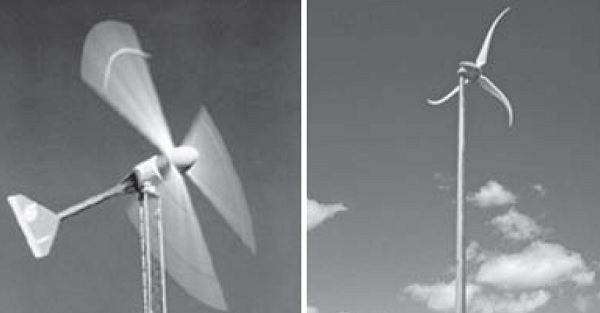
▲Small wind power systems are not used much in the Washington area because the wind is not strong enough.
The geothermal heat pump system consists of a heat pump (generally located indoors), an underground heat exchanger (generally composed of a pipe network, used to store energy during cooling and extract heat from the ground during heating), a distributor (air duct or underground radiation pipe, Distributing hot or cold air to various rooms) consists of three things (as shown in the picture below). Because the components of the geothermal pump system are either underground or inside the house, it does not affect the appearance, and even nosy neighbors have no way to complain. Furthermore, the geothermal heat pump system has nothing to do with the weather. If it can be combined with some solar systems and small wind systems that rely on the sky, it will achieve seamless beauty and make the house completely self-sufficient in energy.

▲Geothermal heat pump system.
Interestingly, there is also a system called "human motion energy" that is being developed. It uses the friction between the human body and the floor in the stair treads or walkway boards in the house to generate energy. The United States and Japan are currently conducting trials of human movement energy systems in subway stations and other places where people gather. As we all know, wind farms are called "wind farms." In the future, we can also use "crowd farms" where people walk or wheels roll to generate electricity. Large-scale shared farms, combined with self-generated energy in various buildings, may help wean mankind from dependence on fossil fuels.
Smart house examples
In the area where the author lives, apart from a few attempts at wind power generation (such as the construction of fourteen wind turbines at the local waterworks), solar systems are most commonly used in shops and residences. Solar energy systems can be divided into three types: solar water heaters, solar hot air and solar power generation and air-conditioning systems. Due to the preferential policies of the government and manufacturers, many businesses and residential areas have begun to install them. For example, the authors (Chen Shaoming and Wen Yingqian) recently installed solar water heaters in their homes, with good results.
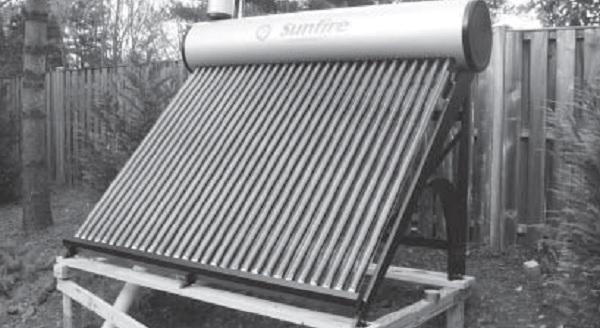
▲The cylindrical water tank above the solar water heater can maintain heat for 80 hours.
In addition, the author (Chen Shaoming) recently assisted in a bold energy self-sufficiency design in the second phase of a "smart" house in the Potomac area of Washington. All the above three systems were used, hoping that the house would be close to "autonomous" house" level. This house covers an area of more than 7,000 square feet. The author has already left hints in the design of the first phase of the project: green is used in the entrance wall, the dropped ceiling of the kitchen island bar and the leaky window in the upstairs bar. The symbol of energy (as shown on the right): This indicates the arrival of "eating tail" energy in the second phase of the project.
In the second phase of the project, a Luyuan company designed and installed solar water heaters and solar hot air systems (designed and installed by the author Feng Jianjun). After manufacturer rebates (Rebate), tax reductions (Tax Credit) and energy support (Energy Grant), the house The Lord spends nothing. Both systems use a special black chemical paint on the back of the solar panel to create a small greenhouse effect in the gap. The water is heated and sent to the water tank of the solar water heater, or the heated air is blown into the air duct of the central air conditioning system. ; No batteries are needed, and the lifespan can reach more than thirty years. The water in the solar water heater tank can be kept warm for eighty hours.

▲Laying a large area of solar panels on the smart roof not only absorbs solar energy, but also extends the life of the roof and blocks sunlight.
Finally, the house's third source of energy is a solar power system, designed by another green energy company, which emits forty-four gleaming solar panels on the eye-catching roof, giving it a high-tech feel. Tech ) high sophistication. The power generated by this system is 10,000 watts, which is more than what is needed for this house. There are two main reasons: 1. It uses a two-way electric meter. When the power generation is excessive, the electricity is supplied to the main grid, and when there is not enough power, it is taken back from the main grid. 2. At present, the effect of polycrystalline photovoltaic panels will still weaken in the first three years, and then the attenuation will be very small. Therefore, the design exceeding the requirements also takes this into consideration.
This system is relatively expensive, and after various discounts, the homeowner still has to pay more than $40,000. However, considering that electricity prices in the United States are rising year by year, and this house consumes a lot of electricity, it seems that it is still cost-effective to get the capital back in less than ten years. The three solar systems show their talents here and cooperate with each other, making the ideal of "food tail" style autonomous houses come ahead of schedule.
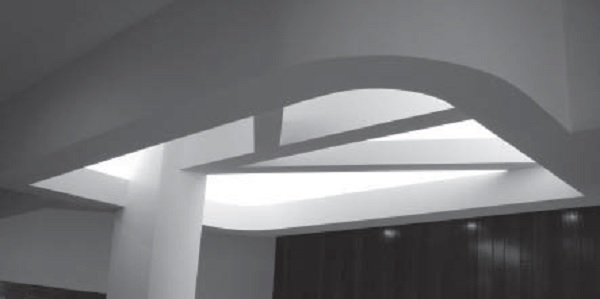

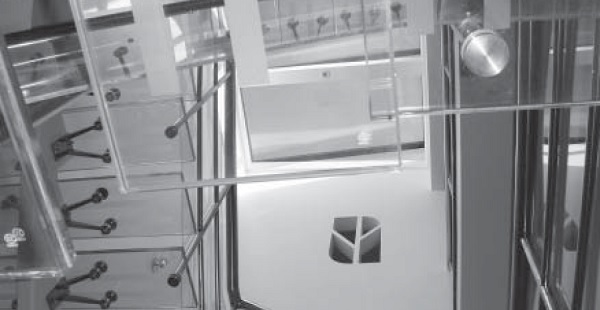
▲The ceiling, kitchen, stairwell, and second floor all use green energy symbol windows, which heralds the arrival of "food tail" energy in the second phase of the project.
The form of this house is contemporary, and it is characterized by a high ceiling, giving it a bright and spacious feeling. However, the thermal insulation effect is worse than that of common colonial houses in the United States, so it consumes more energy. Nowadays, large-area solar panels are laid on the roof, which not only absorbs solar energy to provide hot water, heating and power generation for the house, but also adds a thick protective layer to the roof, extending the life of the roof. In addition, the sun does not directly shine on the roof of the house in summer, which effectively reduces the temperature of the house, which can be said to kill several birds with one stone.
After all solar systems are installed, and after a trial period, you can consider whether to install a geothermal pump system to supplement it. In this way, green buildings and green energy are providing a healthy and comfortable living space for people who are moving towards green energy life, keeping our earth away from deserts and keeping green forever.
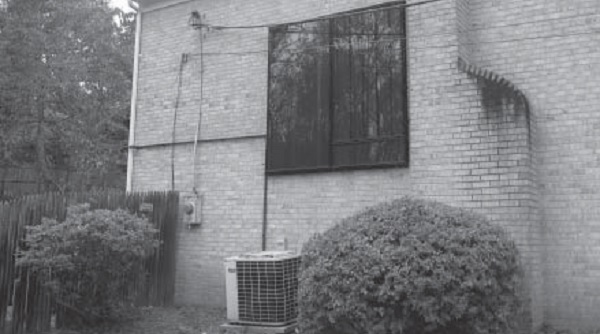
▲The green energy device on the kitchen ceiling—solar heater.
Conclusion
The purpose of God’s creation of humans is to enable humans to manage and subdue the earth (see Genesis 2:26, 28). Human beings have unshirkable responsibilities in environmental protection, energy conservation and carbon reduction.
It is estimated that if there is no change in the way energy is used, oil reserves will be exhausted by the middle of this century, and mankind will face a catastrophe. Relatively speaking, renewable energy such as solar energy is inexhaustible; therefore, major countries in the world are emphasizing green energy and developing green energy industries to make the economy a sustainable economy. Several WWS systems mentioned in this article have become popular in commercial and residential areas in the United States. In addition to responding to the government's energy-saving policies and enjoying tax-saving benefits, they can also create a good environment for society with less pollution and less consumption of "non-renewable energy."
Note
1. See explanation: http://en.wikipedia.org/wiki/Ouroboros
2. Chen Shaoming and Zhang Mingyu, "A new discipline that meets the needs of the times—A review of energy-saving architecture," "Architect" magazine, August 1981, pp. 87-101.
3. According to the United Nations' estimated carbon dioxide emissions data, the world emitted a total of 2,843 metric tons in 2006; China emits the most, with a total of 6.1 million metric tons, accounting for 21.5% of the world; the United States is second, with 575 metric tons and 20.2%. But in terms of emissions per person, the United States ranks first with 18.67 metric tons, Russia 11.03 metric tons, the European Union 7.84 metric tons; China 4.57 metric tons, which is only slightly higher than the world average of 4.18 metric tons. See http://en.wikipedia.org/List_of_countries_by_carbon_dioxide_emissions.
4. United Daily News e-newsletter, "Norway's clean energy mix of fresh water and sea water... calls", November 24, 2009.
5. If you want to know about the tax cuts and incentives implemented by the U.S. federal and state governments, you can check online: http://dsireusa.org
 Chen Shaoming, a licensed architect, is a retired associate professor at the School of Engineering, Architecture and Computer Science at Howard University in Washington, DC.
Chen Shaoming, a licensed architect, is a retired associate professor at the School of Engineering, Architecture and Computer Science at Howard University in Washington, DC.
 Wen Yingqian is a distinguished professor at Yuan Chi University in Taiwan and an honorary professor at National Dong Hwa University.
Wen Yingqian is a distinguished professor at Yuan Chi University in Taiwan and an honorary professor at National Dong Hwa University.
 Feng Jianjun, Ph.D. in biochemistry, is an energy expert at Sunfire.
Feng Jianjun, Ph.D. in biochemistry, is an energy expert at Sunfire.
